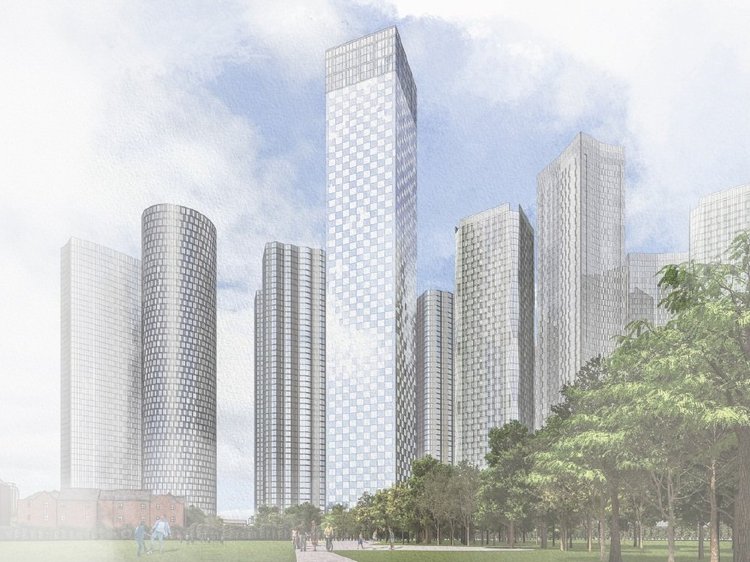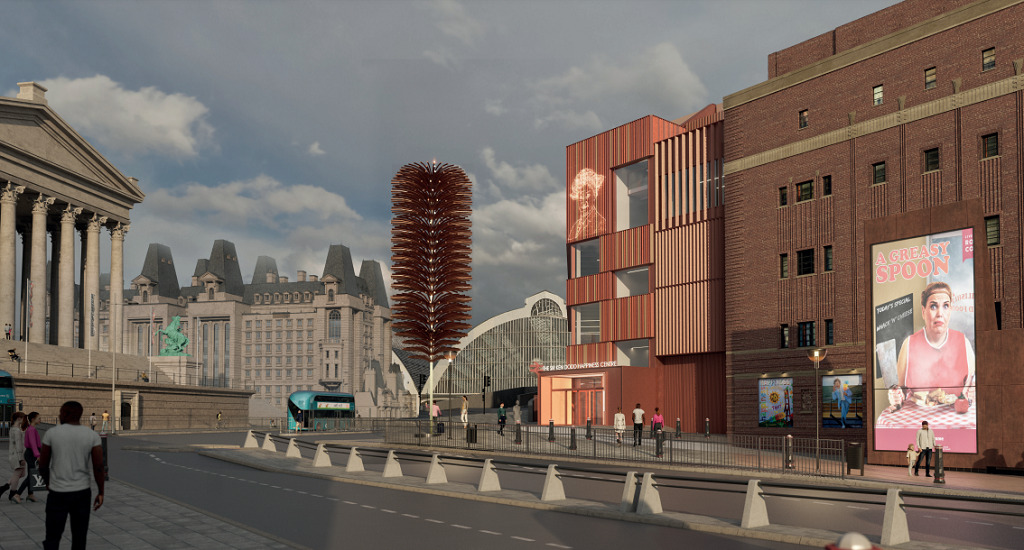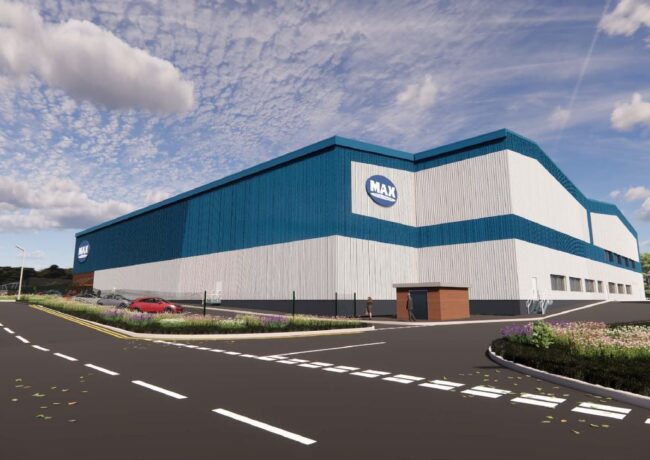The Subplot
The Subplot | Manchester’s lofty ambitions, Liverpool office activity, industrial interference
Welcome to The Subplot, your regular slice of commentary on the business and property market from across the North of England.
THIS WEEK
- Dan Whelan asks if the sky is the limit for Manchester’s soaring cityscape
- Elevator pitch: your weekly rundown of who and what is going up, and who is heading the other way
HOW FAR CAN THE TRANSFORMATION OF MANCHESTER’S SKYLINE GO?
This week saw prolific developer Renaker unveil plans for Manchester’s first 70-storey building as part of the ongoing regeneration of Great Jackson Street.
Coming in at 213 metres, it is taller than the 201-metre South Tower – another Renaker scheme – which has been the city’s tallest building since 2018.
The continued upward trajectory of Manchester’s skyline is no surprise. Land is scarce, which means if the city is to stand any chance of providing the homes its booming population demands, the only way is up…right?
No limits?
Manchester now has two towers taller than 200 metres, with at least one more rumoured to be on the way this year. But is the ground beneath Manchester fertile enough for a 300-metre building to grow?
Known as supertalls, these 300-metre-plus skyscrapers on steroids can be found in places like New York, China, and the Middle East.
Currently, the Shard in Central London is the UK’s only supertall. Height restrictions there due to the proximity of the capital’s City Airport mean that going much higher in future could be out of the question.
Manchester has no such restrictions, but between the city’s relatively meagre – on global terms – property values and the premium that comes with constructing tall buildings, the likelihood of seeing a supertall within the inner ring road is slim, according to industry experts.
“It won’t happen in my lifetime,” says Ian Simpson, one half of SimpsonHaugh Architects, which has designed seven of the eight tallest buildings currently standing in Greater Manchester – including six for Renaker.
Deloitte partner John Cooper, another of Renaker’s trusted partners, believes the current project might be pushing the limit of what is achievable.
“We won’t go much taller than 70 storeys in my career,” he says.
The chief culprit for lack of supertall ambition in Manchester is profitability. It simply doesn’t stack up.
“I just can’t see it from a viability perspective,” Cooper says, regarding skyscrapers taller than 70-ish storeys. “I can’t see anyone being able to get higher than that.”
Debating design
Viability doesn’t only impinge on height, it also limits an architect’s creativity.
When Simpson’s plans for the latest skyscraper for Renaker emerged, people were divided.
Some loved the proposals, which were inspired by a lighthouse, while others gave the thumbs down, labelling them boring glass boxes.
When confronted with the criticism, Simpson shrugs. “If you put your head above the parapet, it will get shot at,” he says.
SimpsonHaugh designed One Blackfriars in London, a 165-metre residential tower that Simpson describes as “the most beautiful tall building in the country”.
The margins to develop something similar outside the capital simply aren’t there, he says.
“The sales values there were £2,000/sq ft so even a studio was a million quid. When you’ve got those sorts of values, you can build those sorts of buildings.”
By way of comparison, sales values in Manchester vary between £400/sq ft and £600/sq ft, depending on who you ask.
The affordability question
As well as stunting growth and providing a barrier to expansive design, tight margins are also stymieing the delivery of something far more important.
Making a scheme stack up and meeting a local authority’s affordable housing targets are tricky businesses, even for a company with Renaker’s expertise.
Like other projects in its portfolio, the developer’s latest project proposes a lot of homes, some 2,388 in fact, none of which are affordable. Ultimately it will be up to Manchester City Council to push back on this point.
In the past, the council has called for planning reform to give it more powers to demand that private developers deliver affordable housing.
Until that happens, the city will have to be happy with other benefits captured through the Section 106 process, such as the school Renaker is delivering at Crown Street.
Speaking to Subplot last year, Cllr Bev Craig, Leader of Manchester City Council said it is sometimes “too easy to focus on the perceived negatives of development in our city” and urged us to remember the positive impact the schemes can have.
If not Ren then who?
If Renaker had said ‘yes’ to Subplot’s requests for an interview, the issue of viability and affordable homes is one that certainly would have been broached.
Alas, Renaker managing director Daren Whitaker is not a man for the limelight.
Perhaps it is this approach, concentrating on the task at hand rather than wasting energy on public relations, that has allowed Renaker’s reputation as a relentless deliverer to emerge organically.
“We have been incredibly lucky to have a developer like Renaker,” Simpson says. “[Without them] we wouldn’t have built anything because you need that skill base to know how to build a 52-storey building without it costing an arm and a leg.”
Indeed, without Renaker, Manchester’s skyline would look drastically different.
Dreams of density
While Renaker has received its fair share of criticism for not providing on-site affordable housing, Whitaker can happily say he has never been embroiled in a debate around Green Belt
Maybe that is the quid pro quo.
To Simpson, building tall in cities makes good economic sense and goes some way to addressing Manchester’s chronic shortage of housing.
For him, density is the name of the game.
“We feel very strongly that what Manchester needs is people. I think we need to get to 200,000 people living in the city centre,” he says.
Manchester currently has around 65,000 city centre residents and the idea of a bustling, dense city is something the architect passionately believes in.
“I think we could probably have at least twice as many towers,” Simpson says. “I don’t believe there’s a saturation point.”
If the idea is to attract as many people to live in Manchester city centre as possible, building tall offers a viable solution to the housing crisis.
By the time both Great Jackson Street and Trinity Islands are complete, Renaker will have built enough homes to accommodate the population of Wilmslow, according to Simpson.
Indeed most Wilmslow residents would actually be able to afford to relocate to a Renaker tower should they wish. Residents in similarly-sized, less affluent areas like Ashington, would not.
Confidence or arrogance?
It has long been espoused that tall buildings are a symbol of a progressive, confident city.
For Deloitte’s John Cooper, the city’s soaring skyline is an indication of how far Manchester has come in recent years.
“When Beetham Tower was built in the noughties, it was about moving away from that perception of Manchester as being a dirty old town and the satanic mills, and becoming more modern and progressive,” he says.
Not everyone thinks tall buildings are good for brand Manchester.
Jon Silver, a geographer at the University of Sheffield’s Urban Institute, says the theories that underpin the building of skyscrapers are “wedded to an out-of-date economic model”.
He argues that they are bad for the city because they don’t provide affordable homes and rent paid on the apartments often vanishes overseas, rather than being funnelled back into local economies.
Skyscrapers, Silver says, are “not a good way to do urbanism”.
Try telling that to Ian Simpson.
 ELEVATOR PITCH
ELEVATOR PITCH
Going up, or going down? This week’s movers
The office market in Liverpool opts for the stairs. Meanwhile, sheds take a tumble downwards.
 Liverpool’s office market
Liverpool’s office market
Eurovision officially launched in Liverpool this week, while plans for Boxpark’s first venue outside the capital were approved. But it’s not all cheesy music and shipping containers, Liverpool’s office market is also off to a decent start in 2023.
So far, we have seen Direct Line return to the city after a decade-long absence, while Green Switch more than doubled the size of its office at Exchange Station. There is more to come, too, if market whispers are to be believed.
The city is finding new uses for its less prime space – Peel L&P recently let a 9,000 sq ft chunk of Princes Dock to a private hospital, while Cert Property has given up trying to find occupiers at Centric House, opting to convert the property into apartments instead.
All of this is good news, and suggests a proactive and lively market. Could long-awaited activity on a pre-let at Pall Mall or a speculative office development at Liverpool Waters be next?
 Shed shortage
Shed shortage
There are just six months of Grade A industrial supply available in the North West. That’s according to a report by Savills, which states that industrial take-up in 2022 exceeded 7m sq ft.
But actually the picture is better than it seems. The supply of industrial space across the region actually rose 32% year on year in 2022, says Savills.
There is still an imbalance between the region’s supply and its demand. This is evidenced by rising rents, up 13% compared to 2021.
This wonky dynamic is not going to be helped by Whitehall meddling.
This week, Place North West reported that planning inspectors are toying with the idea of removing a 338-acre employment allocation from Warrington Council’s emerging local plan.
The inspectors say Warrington has overestimated how much industrial space it needs, which could mean curtains for 3m sq ft of pipeline proposed by Langtree and Panattoni.
Get in touch with Place North West news@placenorthwest.co.uk





So what is Jon Silver’s alternative economic model for delivering much needed home in the core of the conurbation at the density needed to make best use of the limited land we have and thereby help protect the green belt? We need to produce homes at all price points both to rent and to own – and this is not just a debate about the city centre.
By Anonymous
Regarding sheds, with Liverpool Freeport now official and according to their spokesman at another new warehouse launch in Speke, there will be great opportunities for new builds in the freeport zone.
By Liverpolitis
Re Liverpool office market, for example Peel can`t even attract a high-rise speculative office development on Princes Dock/Liverpool Waters, even after 15 years , meanwhile the City Council dithers over Pall Mall.
HS2, or the lack of it, will leave Liverpool struggling, as already can be seen with developers flocking to Brum or Mcr, if only we can get a glimmer of something positive re NPR. In the meantime Avanti promised 2 trains per hour Euston to Lime Street, is that still happening, as transport links are vital for businesses, remember this was cited by Channel 4 when they rejected Liverpool as their Northern outpost.
By Anonymous
A lot of DS residents are students, the majority of the rest are under 30, they’ll need to attract an older demographic is they want to continue to let these out, but why would somebody 40+ want to live here when they don’t now?
By DH
Quality over quantity/the obsession with height that some comments have on here. All these towers look pretty similar.
By Levelling Up Manager
Jon Silver lives in a utopia where Manchester can be Vienna, instead of a city within a state that starves it of resources and power. The question of whether these towers are good urbanism is a good one though. For a site next to Mancunian Way towers make a lot of sense, but more generally I’d say Ancoats is a better model. MCC has the land outside the core build significant volumes of affordable homes, and for the long term health of the city it needs to get that right. If you look at cities who have done towers well as part of good urbanism, most people would say Vancouver, but if you take the model the quality of public realm is very high.
By Rich X
Wait for the announcement of the 300m Tower.
By Elephant
Limits the Architects creativity? What Simpson has come up with for this scheme certainly smacks of a lack of creativity.
By BDAY
More attention should be given to design than height- though the two are clearly closet linked, the quality of design is simply shocking. Going for towers full stop has a hindering impact on design quality, though Manchester takes mediocre design to another level- bland grey and green glass and steel cuboid structures that could exist anywhere and all look the same. It is also difficult to create an interesting streetscape with tower clusters and this is clearly seen at the lower end of Deansgate. Why is the design community not up in arms at all this! This article would be better advised to discuss the issue of design quality in the city.
By Anonymous
Really disappointing “Liverpool City”….Nothing being done to generate wealth….Sad about Manchester; all the work being done to give people a good quality living space , great that their building up . Only 70 floors , I’d have hoped for 100…..Subplot great info service ….why is Liverpool not prepared to allow investors to develop the City…….
By Shaun Mackin
Walked around Jackson St recently and thought it’s starting to look really good. Takes a long time for a district to develop and this will be years yet in the building. Most important is of course linking to the street and developing community like the school, doctors, local shops but even that seems to happening. I hope the same is happening around the other cluster at Greengate. If that happens it’s not just the skyline that will look incredible.
By Simon
What is Simpson talking about? Has he lost his mind, yes agree that Manchester couldn’t afford towers like One Blackfriars but his job as an architect is to actually put some thought and artistry into the design. What he’s done is come up with something that lacks any creativity or design flair, even with cost limitations he could’ve still changed the facade of the tower or introduced some other shapes like slight taper or modify the roofline. ‘Lighthouse inspired’? From which angle does this tower look like a lighthouse? Manchester is quickly loosing its identity, it’s extremely painful to watch.
By Michael
Simpson`s best ever was Brunswick Quay in Liverpool, 50 floors, refused by Ruth Kelly MP Secretary of State, because the locals complained about their loss of views to the Wirral, and vice-versa.
By Anonymous
I actually think Simpsons best is one they built,The Crown St Victoria , it looks a little different to some of the others, at least until they complete the 360 . As for Manchester losing its identity, well some of it yes, the identity of Smokey , industrial dereliction and good riddance to it . Districts like this and Greengate are just that ,districts, they add to the identity not define it any more than Ancoats or the Civic quarter do. Manchester is way too big now for that.
By Charles
@Michael – Ian Simpson is only one part of rh equation. Anyone can come up with wacky shapes, crazily complex cladding designs and all manner of features but is it buildable? Moreover is it buildable within the constraints of material costs, selling price and expectations for profitability? Ultimately it’s the developer who takes these risks and who sets the parameters within which the architect can design. To deliver a 70 floor tower of any description, in a regional city is an incredible feat, the ambition and ability to deliver something of this scale should be applauded.
By Realist
The most stupid comment is describing One Blackfriers “the most beautiful tall building in the country”. The plastic looking cladding is awful.
By Bradman